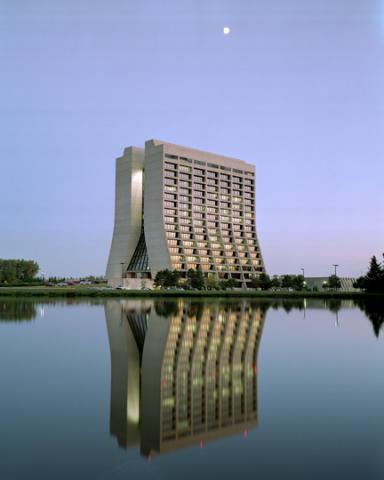
New measurements announced today by scientists from the CDF and DZero collaborations at Fermilab in Batavia, Illinois, indicate that the elusive Higgs boson may nearly be cornered. After analyzing the full data set from their Tevatron accelerator, which completed its last run in September 2011, the two independent experiments see hints of a Higgs boson.
Physicists from the CDF and DZero collaborations found excesses in their data that might be interpreted as coming from a Higgs boson with a mass in the region of 115 to 135 GeV. In this range, the new result has a probability of being due to a statistical fluctuation at level of significance known among scientists as 2.2 sigma. This new result also excludes the possibility of the Higgs having a mass in the range from 147 to 179 GeV.
Physicists claim evidence of a new particle only if the probability that the data could be due to a statistical fluctuation is less than 1 in 740, or three sigmas. A discovery is claimed only if that probability is less than 1 in 3.5 million, or five sigmas.
Consistent Results
This result sits well within the stringent constraints established by earlier direct and indirect measurements made by CERN’s Large Hadron Collider, the Tevatron, and other accelerators, which place the mass of the Higgs boson within the range of 115 to 127 GeV. These findings are also consistent with the December 2011 announcement of excesses seen in that range by LHC experiments, which searched for the Higgs in different decay patterns. None of the hints announced so far from the Tevatron or LHC experiments, however, are strong enough to claim evidence for the Higgs boson.
“I am thrilled with the pace of progress in the hunt for the Higgs boson. CDF and DZero scientists from around the world have pulled out all the stops to reach this very nice and important contribution to the Higgs boson search,” said Fermilab Director Pier Oddone. “The two collaborations independently combed through hundreds of trillions of proton-antiproton collisions recorded by their experiments to arrive at this exciting result.”
The Higgs
Higgs bosons, if they exist, are short-lived and can decay in many different ways. Just as a vending machine might return the same amount of change using different combinations of coins, the Higgs can decay into different combinations of particles. Discovering the Higgs boson relies on observing a statistically significant excess of the particles into which the Higgs decays and those particles must have corresponding kinematic properties that allow for the mass of the Higgs to be reconstructed.
“There is still much work ahead before the scientific community can say for sure whether the Higgs boson exists,” said Dmitri Denisov, DZero co-spokesperson and physicist at Fermilab. “Based on these exciting hints, we are working as quickly as possible to further improve our analysis methods and squeeze the last ounce out of Tevatron data.”
Only high-energy particle colliders such as the Tevatron and LHC can recreate the energy conditions found in the universe shortly after the Big Bang. According to the Standard Model, the theory that explains and predicts how nature’s building blocks behave and interact with each other, the Higgs boson gives mass to other particles.
“Without something like the Higgs boson giving fundamental particles mass, the whole world around us would be very different from what we see today,” said Giovanni Punzi, CDF co-spokesperson and physicist at the National Institute of Nuclear Physics, or INFN, in Pisa, Italy. “Physicists have known for a long time that the Higgs or something like it must exist, and we are eager to finally pin this phenomenon down and start learning more about it.”
If a Higgs boson is created in a high-energy particle collision, it immediately decays into lighter more stable particles before even the world’s best detectors and fastest computers can snap a picture of it. To find the Higgs boson, physicists retraced the path of these secondary particles and ruled out processes that mimic its signal.
Complimentary Methods
The experiments at the Tevatron and the LHC offer a complementary search strategy for the Higgs boson. The Tevatron was a proton/anti-proton collider, with a maximum center of mass energy of 2 TeV, whereas the LHC is a proton/proton collider that will ultimately reach 14 TeV. Because the two accelerators collide different pairs of particles at different energies and produce different types of backgrounds, the search strategies are different. At the Tevatron, for example, the most powerful method is to search the CDF and DZero datasets to look for a Higgs boson that decays into a pair of bottom quarks if the Higgs boson mass is approximately 115-130 GeV. It is crucial to observe the Higgs boson in several types of decay modes because the Standard Model predicts different branching ratios for different decay modes. If these ratios are observed, then this is experimental confirmation of both the Standard Model and the Higgs.
“The search for the Higgs boson by the Tevatron and LHC experiments is like two people taking a picture of a park from different vantage points,” said Gregorio Bernardi, DZero co-spokesperson at the Nuclear Physics Laboratory of the High Energies, or LPNHE, in Paris . “One picture may show a child that is blocked from the other’s view by a tree. Both pictures may show the child but only one can resolve the child’s features. You need to combine both viewpoints to get a true picture of who is in the park. At this point both pictures are fuzzy and we think maybe they show someone in the park. Eventually the LHC with future data samples will be able to give us a sharp picture of what is there. The Tevatron by further improving its analyses will also sharpen the picture which is emerging today.”
Adapted from a Fermilab press release: Full press release & images
